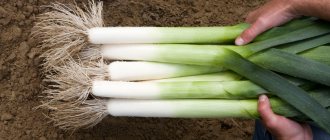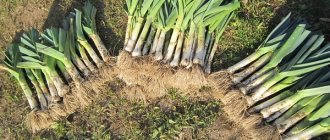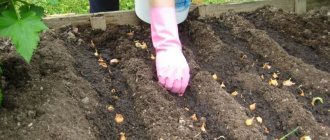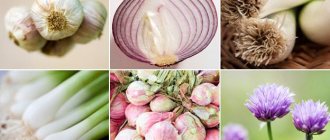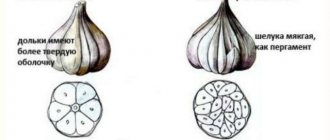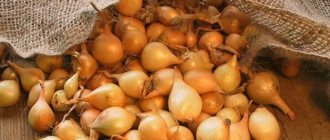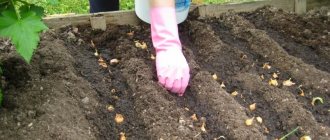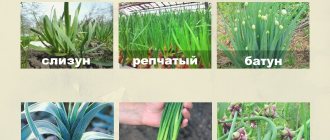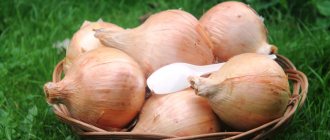Description of the variety
Leek is a biennial crop. In the first year, you can grow a stem with leaves that are eaten. The second season is getting seeds.
| Height of the stem (false stem) | 10-50 cm |
| Leg diameter | 2-5 cm |
| Leaf length | 90-150 cm |
| Leaf Shape | Flat |
| Number of leaves of the first year plant | Up to 12 |
| Weight of one copy | 200-300 g |
| Bloom | July-September |
| Collecting seeds | September October |
The second name for leeks is pearl. Pearl onions were grown in ancient Egypt; thanks to their rich vitamin and mineral composition, leeks were called “the food of the rich” in ancient Rome.
Unlike other varieties of onions, this crop does not form a head. The thickened stem and long leaves are eaten. The plant reaches a height of 90-150 cm.
Today, several varieties of leeks are grown, which differ from each other in terms of ripening:
- Early – 130-150 days. These are “Vesta”, “Elephant Trunk”, “Columbus”.
- Average ripening – 150-180 days. These include “Elephant”, “Cazimir”, “Winner”.
- Late – 180-200 days. Varieties “Autumn Giant”, “Karantansky”, “Bandit”, “Good fellow”.
Planting methods
Leeks are grown mainly by seedlings. The southern regions can afford direct cultivation from seeds, but only with the use of film cover, which will protect young plantings from possible return frosts and from excess moisture during the spring rains. Other regions use seedlings.
Seeds
The seed method of growing leeks is possible only in warm climates. Even in the southern regions, it is recommended to sow this crop in open ground at the end of April - beginning of May, when a stable above-zero temperature has established, the soil has warmed up to +15°C and the period of recurrent frosts has passed.
Pearl onion seedlings do not tolerate frost at all.
The key to successfully growing leeks with seeds is properly selected soil. This crop is suitable only for light soils with low acidity. If you sow seeds in acidic soil, seedlings may not appear at all. Adding black soil to the soil will help increase the likelihood of getting a good harvest.
The seed method is used when growing leeks as a two-year crop to obtain seeds.
In this case, sowing is carried out at the end of June. In October, the plants are earthed up and protected from the cold for the winter. In the southern regions, winter sowing is also possible to obtain early shoots in the spring.
Seedlings
The seedling method is suitable for most regions of the country. Given the long growing season, seeds begin to be sown in February. For Siberia, the deadlines are moved forward a month. The optimal age of seedlings for transferring to a permanent place of cultivation is 60-70 days. In the northern regions, it is recommended to grow pearl onions in a greenhouse.
The seedling method is more predictable than the seed method. If you correctly calculate the timing of transplanting seedlings, you can achieve almost 100% maturity.
Diseases and pests
The greatest danger when growing leeks at home is the onion fly. The insect sucks the juice from the young shoots of the crop. Whitish stripes and gaps remain on the leaves. Caterpillars hatching from larvae feed on the succulent bulbs. For prevention, it is recommended to disinfect the soil before planting. When a pest attacks, you should spray with garlic infusion and cover the rows with ground carrot seeds, the smell of which repels the insect.
Onion fly larvae
Onion-garlic solution for pests
Downy mildew
Rust
If not properly cared for, leeks can be susceptible to various fungal or viral diseases. The most common of them are downy mildew and rust.
Diseased plants should be destroyed so that fungal spores or viruses do not infect other plants.
Landing dates
The timing of planting onions depends on three factors:
- growing region;
- varieties;
- phases of the moon.
Climatic features of the region
In central Russia, early ripening leek seeds are sown for seedlings in early April. Mid-season - at the end of February - the first half of March. Late - at the end of January - the first half of February.
For northern regions, the recommended sowing dates are shifted a month ahead. The seedlings are transferred to the ground or greenhouse after 1.5 months. A prerequisite for growing is temperature during the day +15…+17°С, at night – +10…+13°С.
According to the lunar calendar
Considering that leeks do not produce heads, when growing them, the rules of work according to the lunar calendar apply for plants with a growing aerial part. All work with this crop is carried out during the waxing moon.
Favorable zodiac signs for all bulbous people are Taurus, Virgo and Capricorn. During the new moon and full moon, sowing is completely prohibited. In the declining phase, it is recommended to harvest the crop.
Note to the gardener
To get a good harvest of leeks, you need to know a few tricks. For example, which variety to choose for planting, how to collect and save seeds. It will also be interesting to get acquainted with the beneficial properties of this vegetable.
Popular varieties of leeks
All varieties of leeks are divided into 3 groups depending on the ripening period - early, mid-ripening, late. Each of these categories has its own leaders who are popular among summer residents.
The best early varieties of leeks:
- "Columbus" . The variety was bred in Holland. Onions are ready to eat 85 days from the moment of sowing. The plant does not require hilling and is resistant to cold.
- "Vesta". This is a proven variety of Russian selection. Onions have gained popularity due to their good taste, resistance to disease and cold, and high yield. The ripening of the vegetable occurs in 4 months.
- "Elephant's trunk" . A productive variety with dark green leaves. Its advantages include a long shelf life.
The best mid-season varieties of leeks:
- "Winner" . The plant is winter-hardy; its gray-green leaves, which appear in the second year, are also suitable for food. Onions have a delicate, sweet, slightly spicy taste.
- "Elephant" . The variety ripens within 4.5 months from planting. The plant is resistant to drought and low temperatures, but requires regular hilling. The taste is dominated by sweetness. Onions are used fresh and for cooking.
- "Casimir" . The growing season is 5 months. The plant is compact in size due to the vertical arrangement of the leaves. This allows for a tighter fit.
The best late varieties of leeks:
- "Alligator". Not only the stem is eaten, but also the aromatic leaves, which have a garlic flavor. The variety is distinguished by good yield and elongated white part.
- "Bandit" . The variety was bred in Holland and can be grown as a two-year crop. In this case, the onions are planted later than usual. You can grow a longer white leg in 1 season by regularly hilling the plant.
- "Karantansky" . An old Russian variety with dark green leaves covered with a waxy coating. It has excellent taste. Onions require 6-7 months to ripen. The harvest can be harvested gradually, starting 5 months after sowing. Requires cultivation through seedlings.
In central Russia, in addition to the listed early and mid-season varieties, you can also grow “Goliath” and “Tango”. The best regionalized varieties for Siberia are “Dzholant”, “Columbus”, “Tango” and “Kilima”.
How to collect your own leek seed
To collect seeds, leeks must undergo vernalization (overwintering in the open ground or in pots in cool storage). Keeping them in such conditions helps the plants shoot, bloom and produce seeds. Flower arrows are formed when the feather has fully grown.
The bolls are left on the plant until the seeds are completely ripe, then the arrows are cut off and wait until the bolls are completely dry. In cold regions, it is extremely difficult to obtain seed material due to the fact that the seeds do not have time to ripen before the arrival of cold weather. In addition, seed material can only be obtained from a two-year-old plant; it is rarely possible to preserve leeks until the next season in harsh winter conditions.
Useful properties of leeks
Leeks have been proven to have medicinal properties. Its regular use is recommended for the following disorders:
- Joint diseases. Due to a significant amount of sulfur, the product reduces inflammation in bone and cartilage tissue.
- Anemia. The plant fibers of this vegetable contain a lot of iron.
- Digestive problems. The substances contained in the product destroy pathogenic microflora, thereby reducing the risk of inflammation of the gastrointestinal tract.
- Respiratory diseases. The high content of essential oils alleviates the condition of lung diseases.
- High cholesterol. If you eat leeks regularly, your “bad” cholesterol levels return to normal.
The product also helps with inflammation of the prostate and intestines. Eating this onion improves the condition of liver and vision diseases. The vegetable relieves the flu.
It is better to avoid eating leek during periods of exacerbation of gastric ulcers or acute gastritis. If you are unsure whether adding leeks to your diet would be beneficial, consult your doctor first. The vegetable is used not only for preparing salads and main courses. A medicine made from honey, lemon juice and leek will be very useful.
To prepare it, the vegetable is cut into rings and placed in a jar of honey, and lemon juice is added (all ingredients are taken in equal parts). Then the mixture is combined with 3 parts olive oil and allowed to brew for 24 hours. The finished drug is taken in the morning on an empty stomach, 30 minutes before meals, 1 teaspoon. The course of treatment lasts 3 months. According to representatives of traditional medicine, this remedy strengthens the functioning of the cardiovascular system and serves as a prevention of thrombosis.
Growing seedlings
Soil preparation
Growing leek seedlings is possible both in purchased soil and in your own prepared soil mixture. If the first option is chosen, then it is better to buy soil specifically for onions, although this crop also feels great in soil for peppers and eggplants. If a self-composed soil mixture is a priority, then you should remember that leeks do not like heavy, acidic soil.
The best option would be the composition:
- Turf land 40%.
- Peat 30%.
- River sand 30%.
Wood ash, sawdust, and eggshells are used as additives. Self-prepared soil mixture is disinfected by calcination in the oven or by watering with a warm solution of manganese. To increase the nutritional value of the soil, superphosphate, urea or compost are added to it.
Preparing containers
When choosing containers for sowing leek seeds for seedlings, there are no special restrictions. It is preferable to plant them in separate containers, or even better, in peat pots or tablets without subsequent picking.
The height of the sides of containers for seedlings is at least 15 cm. To save space, you can use special cassettes instead of boxes. Before sowing seeds, containers made of plastic and wood are disinfected with a manganese solution.
Sowing leeks for seedlings can be done in a “snail”. For it you will need a 10-15 cm wide laminate flooring, a tray, and a thick elastic band.
Seed preparation
- A week before the planned sowing, it is necessary to treat the seeds. First, they are calibrated and seeds with damaged outer shells are rejected. Seeds 2-3 years old are optimal for sowing.
- To speed up seed germination, alternate soaking in warm and cold water. First, the selected seeds are placed in water heated to 40-45°C for 20 minutes, then in water at room temperature for the same time. This will wash off the oil coating.
- The next stage is germinating the seeds in damp gauze. It takes 3-5 days. An alternative preparation method is to soak the seeds in warm water for 24 hours. For disinfection, a standard scheme is used using a 1% manganese solution or treatment with Fitosporin.
Sowing
- If the seeds are sown in individual containers, then 2-4 seeds are placed in each cup.
- If boxes are used for growing, then first grooves are made in the ground, into which one seed is placed every 4-5 cm.
- Seed planting depth is 1-1.5 cm.
- If leek seedlings are grown in a “snail”, then the seeds are laid out every 5 cm, retreating 3 cm from the edge.
- At the time of planting, the soil should be moist, but not wet.
- The seeds placed in the ground are sprinkled with a layer of soil no more than 5 mm.
- The containers are covered with film until shoots appear.
The air temperature in the room where leek seedlings are grown should be +21...+25°C. After the seeds germinate, the film is removed, the temperature is reduced to +18...+20 degrees during the day and to +10...+14 degrees at night.
Seedling care
Leek seedlings are grown on southern windows.
- The optimal lighting mode is 10-12 hours a day. If necessary, the seedlings are illuminated with fluorescent lamps.
- You cannot place containers with seedlings on a cold base so that the developing roots do not freeze.
- Watering - as the top layer of soil dries. Overfilling should not be allowed so as not to cause the development of fungus.
- Water by drip or from a syringe at the root.
- When the crops are dense, thinning with a minimum distance between seedlings of 2 cm is recommended. The first thinning is no earlier than a month after sowing the seeds.
- If the seedlings stretch upward, they are cut, leaving feathers 10 cm long. “Cutting” stimulates the plant to grow roots and thicken the stem.
Feeding
During the seedling period, leeks are fed twice, although some fertilize every 2 weeks. The first time this is done 2 weeks after emergence. Use Nitroammofoska or ready-made compositions such as Kemira-universal.
The second time it is advisable to feed the seedlings 2 weeks before transplanting to a permanent place. In this case, either Nitroammofoska or Azofoska is also used.
The best fertilizer for pearl onions is considered to be an infusion of chicken manure (0.5 kg per 10 liters of water). It is used to water plants at the roots, avoiding contact with young seedlings.
Transplantation into the ground
The optimal age of leek seedlings for transplanting into the ground is 60-70 days. The main sign is that the plants should have 3-4 true leaves.
10 days before plant transplantation, seedlings begin to harden. To do this, the boxes (cups) with seedlings are taken out into the air and left there for 2-3 hours. The temperature should be above zero, approximately +15…+18 degrees. Gradually increase the time until the seedlings stand in the air all night.
1-2 days before transplanting, the plants are watered abundantly. This will make it easy to remove the seedlings without disturbing their root system.
Young onions are planted in grooves 15-20 cm deep. The distance between them is at least 40 cm. The distance between plants is 15-20 cm. Before planting, the roots are cut by a third. It is also necessary to trim the greens, leaving leaves 7-10 cm long.
You need to pour wood ash into the bottom of the groove, place the seedlings there, sprinkle them with 2-3 cm of humus and fill the groove halfway with soil. The voids in the form of a trench will become a natural protection from the wind.
After transplanting, the grooves are watered, trying not to wash away the fresh soil, and protected from precipitation for several days, especially if the weather is cool outside.
How to grow leeks from seeds, planting step by step with photos
When everything is prepared, you can begin planting directly. There are several ways to do this. Let's look at the most popular ones.
How to plant seeds in a container
This work is not difficult, the main thing is to carry it out correctly, without deviating from the scheme:
Fill the container with substrate, a layer of at least 12-15 cm.
Spray the soil with a spray bottle with warm, settled or filtered water.
Mark grooves or holes in the substrate, 1-1.5 cm deep.
Place the seeds in the prepared grooves at a distance of about 2 cm. If you plant in cassette boxes, you do not need to do this.
Cover with a thin layer of earth.
Water the planted seeds again with a spray bottle and hide them under glass, or place them in a transparent plastic bag until the sprouts hatch.
IMPORTANT! It is recommended to place a drainage layer at the bottom of the container.
Sowing seeds in peat cups
This method is very convenient and simple. The tablets are placed in a container with water to swell for 30-40 minutes, after which the excess water is drained.
Using a toothpick or other device, a small depression is made in the swollen tablets, where the seeds are placed.
Dishes with peat tablets are also placed in a bag until the sprouts hatch.
Caring for onions in the ground
- Watering is frequent, but not abundant. Warm water is used for irrigation. After transplantation, the plants are watered for the first time after 5 days. In summer, water consumption is 12 liters per 1 sq.m.
- Regular weeding and loosening are required. Weeds must be removed manually. Loosening 2 times a week.
- When the plant begins to grow larger in the stem, it is necessary to fill the trenches left when planting the seedlings.
- Feed leeks 3-4 times per season. The first time - 20 days after transplanting the seedlings to a permanent place. Use a mixture of urea (20 g) and potassium sulfate (10 g) per bucket of water. The consumption of the resulting solution is 1 liter per 1 sq.m. The remaining times are fertilized with infusion of chicken manure (1:20) or mullein (1:10) every 4 weeks.
- When the onions grow leaves and grow larger in the stem, the beds are mulched. This retains moisture.
- Leeks are rarely susceptible to disease. For prevention, the beds are treated with Fitosporin. To prevent the appearance of onion flies, it is necessary to follow the rules of crop rotation.
- The harvest time depends on the cultivated variety. Early varieties are ready for harvest in August, mid-season varieties in September, while late varieties “sit” in the ground until October. Mature specimens are able to withstand temperatures down to -5°C.
- Pearl onions are not intended for long-term storage. This is a vegetable that is immediately eaten.
- To avoid damaging the stem, dig the onion with a pitchfork. You cannot pull it out of the ground. Dry on the beds.
- The roots of the dug up onions are cut off and damaged leaves are removed. The harvest is stored in boxes, placing the plants at an angle of 50-60 degrees. Each row is sprinkled with sand.
- Store leeks in a cool, dark place (basement) at a temperature of -1...+1°C. Shelf life – no more than 6 months. Leeks can also be stored on the balcony or in the refrigerator.
Preparatory stage
Half of the harvest volume depends on the correct preparatory stage . It includes selection and hardening of seeds, preparation of suitable soil and containers for seedlings.
Seed preparation
High-quality planting material and proper care will ensure a good harvest. Seeds are prepared for planting - hardened and disinfected .
Procedure:
- Boil water and cool it to a temperature of +40...+45°C.
- Place the seeds in a gauze bag and soak in hot water for 25 minutes.
- Rinse the seeds with cool water and place them on a damp cloth.
- Cover the top with a small piece of cloth and leave for 3-5 days.
- During this time, periodically spray the fabric with water from a spray bottle.
- If desired, the seeds can be disinfected in a weak solution of potassium permanganate.
If you bought seeds, you do not need to disinfect them . This is only necessary for self-collected material.
Important! The shelf life of seeds is 2-3 years. With each subsequent year, germination rate decreases.
Preparing soil and containers
Leeks are unpretentious to the soil. The best option is considered fertile sandy-clayey soil . Peat humus pots, which are produced specifically for growing seedlings, are also suitable. After treatment, the seeds are planted in pre-prepared containers with a depth of 12 cm.
Attention! The prepared container should be treated with a disinfectant.
